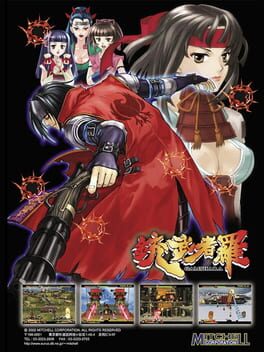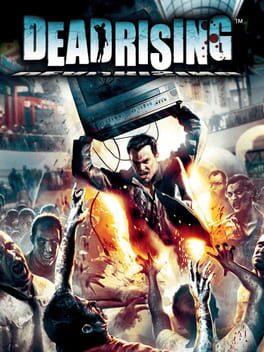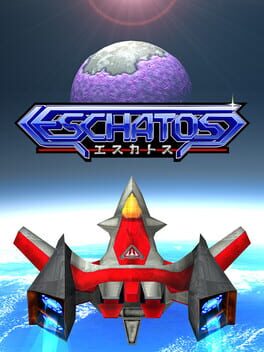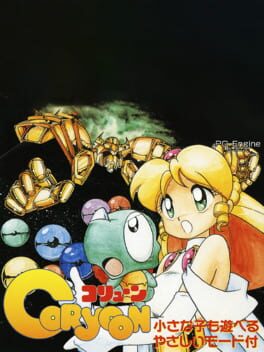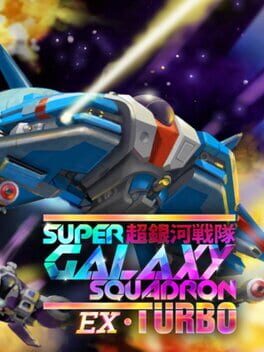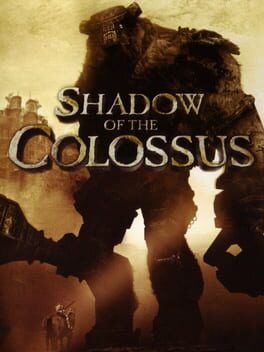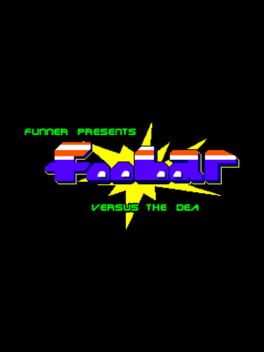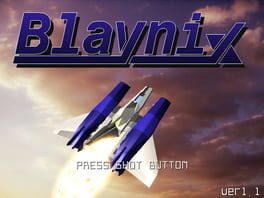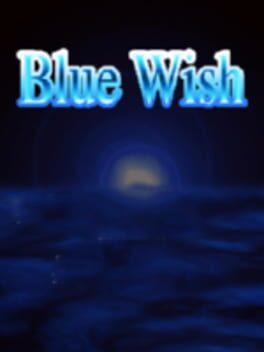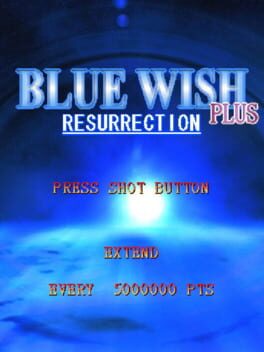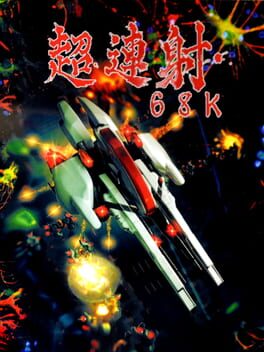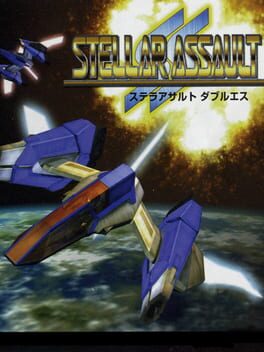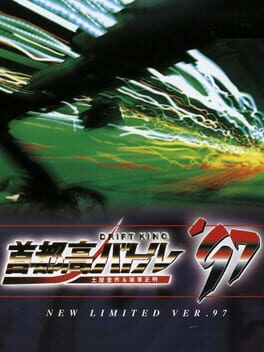torbern
217 reviews liked by torbern
Gamshara
2002
Wild Guns-like that's mostly really excellent, I was surprised how even into the later sections of the game, the enemy patterns stay consistently fair, creative and interesting. Every screen is a densely-packed and panoramic canvas full of things to pummel away at. It gets monotonous due to low damage output though - many later sections force you into jumping to dodge, and you can't fire while jumping, so there's no good way to shoot back, and even if you can, you're doing like 3-5% of their healthbar at a time. By the end of the run I did find myself taking intentional deaths because it was more fun to spam my bomb button rapidfire than to try finding those microscopic opportunities to return fire.
Dead Rising
2006
Despised this when I originally played it, thought it was an underrated gem when I gave it another shot a couple of years ago, and now I’ve finally cooled on it- still a really admirable title, especially as one that was meant be Capcom’s leap into the 7th generation, but it’s decidedly frontloaded upon further inspection. So many of the offputting design choices, like the ever-present timer and weapon durability system, only really matter for the first couple of days when you’re still fumbling around, learning the layout of the mall, and dealing with the constant upsets the game throws at you just as think you’ve gotten a handle on everything.
Even coming back to it now, there’s an impressive streak of early-game roadblocks: the convicts, the gun-store owner, zombies that are deadlier and more numerous at night, and the infamous fight against Adam the Clown, each of which feels like catastrophe incarnate. But this also means these early hours necessitate, and are gratifyingly open to, experimentation. Was able to trivialize the Cletus fight by bringing in the LMG from the convict’s truck, and snowballed that into a much easier fight against Adam by handing out shotguns to a couple of survivors and having them stunlock him in place- a far cry from some of my initial attempts to tackle these fights while eating at away my time to complete objectives. If you value games for the little emergent stories they provide, the near misses and disastrous failures, then Dead Rising’s opening hours alone are well worth the price of admission. Could rattle on about the interesting moments borne out of the pressure to make the best use of your time, like a moment on this playthrough where I had to ferry two incapacitated survivors through the mall in the dead of night- anti-fun in practice, but a fantastically memorable challenge.
Once you get some of the busted boss weapons and deeper into the game, so much of that initial thrill is pared down, with little planning needed to prep for bosses and less overlapping case files to try and optimize. By its final unlockable section, the “Overtime” mode, the game has regressed into something out of the Simple Series: a threatless fetch quest through the mall carried only by the fact that you now have the opportunity to perform you newly-unlocked wrestling moves on hapless groups of Zombies. It’s a disappointing arc for a title that begins so well, definitely something where its most widely-criticized choices are really what brings the game together, and it's the deeper stuff, the scenario design and balancing, that needed further examination.
Would be much easier to let the campaign’s flaws slide if it coexisted with a mode that was totally centered on trying to save as many survivors as possible under a dramatically shortened timer- the game’s additional “Infinite Mode,” where you have to survive as long as possible in the mall while your health slowly drains also seems an inversion of what the real draw of the game is- just a total slog in practice- and even more of a shame given that Capcom normally excels at making supplemental modes that can highlight the best of a game’s mechanics. (Was an ardent RE6 defender for the longest time due to the relative strength of Mercenaries, for instance.)
At the same time, it’s got a million little cool details that are easy to latch onto, like it’s opening, where you learn the photography controls while doing a fly-by of Willamette’s main street, which handily beats Half-Life out as far as atmospheric intros are concerned- a great intro that offers you some early-game experience if you get the most lurid shots of the disaster unfolding on the ground, and crucially, is entirely optional. Or managing to run into the surprising number of optional scenes where Frank is stripped of gear and has to break out of captivity- tense moments I had completely missed on my first time through. And this to say nothing of the mall proper, which might rank as one of the best-realized locations in the medium, with a huge number of unique storefronts to explore. Easy to lose time just rummaging through and exploring the place, a mundane location given real life through sheer craft of world design.
I’m a couple of hours into Dead Rising 2 as of writing this, and it already seems like a more measured and evenly-paced experience, but the first is still worth a try- it’s a deeply flawed game, but it never seems half-hearted in its attempts to pull so many weird directions.
Even coming back to it now, there’s an impressive streak of early-game roadblocks: the convicts, the gun-store owner, zombies that are deadlier and more numerous at night, and the infamous fight against Adam the Clown, each of which feels like catastrophe incarnate. But this also means these early hours necessitate, and are gratifyingly open to, experimentation. Was able to trivialize the Cletus fight by bringing in the LMG from the convict’s truck, and snowballed that into a much easier fight against Adam by handing out shotguns to a couple of survivors and having them stunlock him in place- a far cry from some of my initial attempts to tackle these fights while eating at away my time to complete objectives. If you value games for the little emergent stories they provide, the near misses and disastrous failures, then Dead Rising’s opening hours alone are well worth the price of admission. Could rattle on about the interesting moments borne out of the pressure to make the best use of your time, like a moment on this playthrough where I had to ferry two incapacitated survivors through the mall in the dead of night- anti-fun in practice, but a fantastically memorable challenge.
Once you get some of the busted boss weapons and deeper into the game, so much of that initial thrill is pared down, with little planning needed to prep for bosses and less overlapping case files to try and optimize. By its final unlockable section, the “Overtime” mode, the game has regressed into something out of the Simple Series: a threatless fetch quest through the mall carried only by the fact that you now have the opportunity to perform you newly-unlocked wrestling moves on hapless groups of Zombies. It’s a disappointing arc for a title that begins so well, definitely something where its most widely-criticized choices are really what brings the game together, and it's the deeper stuff, the scenario design and balancing, that needed further examination.
Would be much easier to let the campaign’s flaws slide if it coexisted with a mode that was totally centered on trying to save as many survivors as possible under a dramatically shortened timer- the game’s additional “Infinite Mode,” where you have to survive as long as possible in the mall while your health slowly drains also seems an inversion of what the real draw of the game is- just a total slog in practice- and even more of a shame given that Capcom normally excels at making supplemental modes that can highlight the best of a game’s mechanics. (Was an ardent RE6 defender for the longest time due to the relative strength of Mercenaries, for instance.)
At the same time, it’s got a million little cool details that are easy to latch onto, like it’s opening, where you learn the photography controls while doing a fly-by of Willamette’s main street, which handily beats Half-Life out as far as atmospheric intros are concerned- a great intro that offers you some early-game experience if you get the most lurid shots of the disaster unfolding on the ground, and crucially, is entirely optional. Or managing to run into the surprising number of optional scenes where Frank is stripped of gear and has to break out of captivity- tense moments I had completely missed on my first time through. And this to say nothing of the mall proper, which might rank as one of the best-realized locations in the medium, with a huge number of unique storefronts to explore. Easy to lose time just rummaging through and exploring the place, a mundane location given real life through sheer craft of world design.
I’m a couple of hours into Dead Rising 2 as of writing this, and it already seems like a more measured and evenly-paced experience, but the first is still worth a try- it’s a deeply flawed game, but it never seems half-hearted in its attempts to pull so many weird directions.
Disney's Toy Story
1995
Kind of bullshit throughout the whole runtime but has lots of very interesting technical feats under its belt. The Pizza Planet level is especially interesting, and the first person level is much smoother than anything else of its ilk on the console. Could definitely stand to be more playable in the grand scheme of things, but it's at least endearing.
Really charming Indiana Jones-themed Doom total conversion, fighting through waves of Nazis and undead guardians in ruins around the world. Biggest surprise for me was the strength of the scenario design and pacing- fully expected to see everything the game had to offer by the end of the first episode, but there’s steady introduction of new enemies and weapons, alongside some nice breaks in the formula to keep things interesting. A definite highlight is the start of the Egypt episode, a dense shootout full of destructible props in a museum that’s far more open to exploration than the linear action of much of the rest of the game- and which also demonstrates how strong and varied the roster of hitscan enemies here are.
While I think Venturous is a little too conservative with it’s Doom II analogs, only rarely making you fight Revenant and Archvile equivalents- and usually at the end of episodes- having to prioritize heavy-machine gunners or grenadiers goes a long way in spicing up the action. The best trick it pulls that really capitalizes on this variety is ambushing you whenever you’ve just cleared out an area, foot soldiers pouring in right as you’ve gotten a handle on the undead hordes. It should get stale after a while, but the steady alternation and escalation of these threats more than carries the combat for the duration, bread-and-butter arena fights against monsters and more tactical shootouts against humans.
Ended up wrapping up a playthrough of the 1.3 release right as the newest update dropped, which includes an additional episode in Greece and generally fills out the game really nicely- with an extra visual pass and remixed level arrangements. One of my original criticisms was how weak the ending was, fighting a simplistic boss that you could circle-strafe around and lock down with machine gun fire, now traded out for one where you’re only armed with the magically-infused weapons, the boss now able to use attacks from the entirety of the enemy roster. I didn’t die on either encounter, and it still functionally boils down to circle-strafing it until you deplete its health bar, this newest version is unambiguously the fuller experience- and is a microcosm for the ways the game has been bolstered overall, visually sharper and more novel mechanically.
Even with all the positive changes, levels can still get kind of homogeneous by the end. You can only delve into lost tombs and ancient ruins so many times before it all starts to blur together- as unusual as it may sound from me, probably a sign that the game could’ve used some breaks from all the combat: a couple of gimmick levels, like some kind of teleporter puzzle or a proper labyrinth map could’ve gone a long way at selling the adventurer fantasy in a way combat tunnels just don’t provide (or really go for broke and make a besieged town built over some ruins as a hub area, similar to other shooters like Afterglow and Hedon).
Otherwise, amazing to see the jump in quality from the 1.3 to the 1.5 release- gave me the unusually good problem of having to throw out a bunch of my criticisms on the game, and the newly-included cliffhanger ending has me eager to see what this developer decides to tackle next.
While I think Venturous is a little too conservative with it’s Doom II analogs, only rarely making you fight Revenant and Archvile equivalents- and usually at the end of episodes- having to prioritize heavy-machine gunners or grenadiers goes a long way in spicing up the action. The best trick it pulls that really capitalizes on this variety is ambushing you whenever you’ve just cleared out an area, foot soldiers pouring in right as you’ve gotten a handle on the undead hordes. It should get stale after a while, but the steady alternation and escalation of these threats more than carries the combat for the duration, bread-and-butter arena fights against monsters and more tactical shootouts against humans.
Ended up wrapping up a playthrough of the 1.3 release right as the newest update dropped, which includes an additional episode in Greece and generally fills out the game really nicely- with an extra visual pass and remixed level arrangements. One of my original criticisms was how weak the ending was, fighting a simplistic boss that you could circle-strafe around and lock down with machine gun fire, now traded out for one where you’re only armed with the magically-infused weapons, the boss now able to use attacks from the entirety of the enemy roster. I didn’t die on either encounter, and it still functionally boils down to circle-strafing it until you deplete its health bar, this newest version is unambiguously the fuller experience- and is a microcosm for the ways the game has been bolstered overall, visually sharper and more novel mechanically.
Even with all the positive changes, levels can still get kind of homogeneous by the end. You can only delve into lost tombs and ancient ruins so many times before it all starts to blur together- as unusual as it may sound from me, probably a sign that the game could’ve used some breaks from all the combat: a couple of gimmick levels, like some kind of teleporter puzzle or a proper labyrinth map could’ve gone a long way at selling the adventurer fantasy in a way combat tunnels just don’t provide (or really go for broke and make a besieged town built over some ruins as a hub area, similar to other shooters like Afterglow and Hedon).
Otherwise, amazing to see the jump in quality from the 1.3 to the 1.5 release- gave me the unusually good problem of having to throw out a bunch of my criticisms on the game, and the newly-included cliffhanger ending has me eager to see what this developer decides to tackle next.
Eschatos
2011
Practically perfect, the ultimate design bible for newcoming shmup devs trying to figure out bullet/wave design and VFX, and you can't top Yousuke Yasui's music. Was admittedly worried going in, cause I played Qute's later games (Ginga Force and Natsuki Chronicles) and thought they were terrible. Goes to show less is more for some developers.
Coryoon
1991
1 Credit Clear on Normal - 56,782,505 Points
A charming, simple, and chaotic shmup where you play as a cute little dragon! The scoring system is ludicrous with how easy it is to cheese, 1-ups are plentiful, and there';s so much going on at once that its easy to lose track of where you are VS enemy fire.
However, this game's soundtrack absolutely whips and gets carried with immense charm. Also its short and easy to do a single credit clear! Very nice!
A charming, simple, and chaotic shmup where you play as a cute little dragon! The scoring system is ludicrous with how easy it is to cheese, 1-ups are plentiful, and there';s so much going on at once that its easy to lose track of where you are VS enemy fire.
However, this game's soundtrack absolutely whips and gets carried with immense charm. Also its short and easy to do a single credit clear! Very nice!
Played briefly because it was on sale for a dollar, it's got a lot of ships for a shmup and a neat mechanic where you build up a meter that lets you timestop the enemies. The core shmup design isn't what I want it to be, the enemy waves are stock barren bullet hell patterns, and then the bosses are both way too bullet spongey and way too complex, feels like fighting a boss with the aggression of a Cave boss and the speed of a Psikyo boss. Not my thing.
Somehow the original PS2 release is better than the remakes. Not that they're bad remakes. They're excellent remakes. But there is just some vibe that only the original PS2 graphics can capture. The feeling of "this is the future of video games". It is incredible that this came out on PS2. Similar to Half-Life 2, it's existentially terrifying in its vast world that is nearly barren of civilization. You feel so alone playing it, which makes it even more tragic when you meet a colossus just to take it down. This game is a masterpiece.
Signs Your Man is Gay and Does Crimes: (a) hijacks military-industrial weapons to fight the oppressors, (b) defends the marijuana anarchists of America, (c) must rescue his big '80s-haired goth boyfriend, (d) stars in three Golden Age throwback arcade games reimagining '80s classics as thinly veiled socio-political satire, and (e) was once lost to time like other Macintosh oddities (straight and otherwise), only to get re-discovered decades later
There's a lot to say about Foobar Versus the DEA, a mid-'90s Macintosh vertical shooter outweighed by its messages, subcultural themes, and historic context. Cadensia's review focused on the larger anti-Reaganite/-Clintonite background, while I'm captivated by this game's vision of an alternate history where queer super-heroics could exist in the local pizza parlor, accepted no matter if it fits our definitions of quality. In the words of developers Richard Cross and Tom Cruse: "The game plays like Xevious. We have music, sound, and fun graphics. What is the story behind Foobar? Foobar has been pushed too far. His boyfriend, Ned, has been captured by the DEA." [1] See? It's just like those arcade icons of yesterday, but with something more to say, a reflection of real-world problems that transcends the usual power fantasies. And in this earnestness, I think it mostly succeeds. Moments like grabbing the missile-shaped condom with a US flag, or our hero holding Ned in his arms like ye olde damsels in distress, put a fun, barbed spin on my shoot-'em-up expectations.
In the larger Macintosh software world, this must have felt like a kick in the pants to whoever played it. Let's recall that Apple and Macs in general were limping towards an ignominious demise at the hands of Windows hegemony. All the best shareware releases of the day, like Mighty Mike and Escape Velocity plus big-box legends like the Marathon series could only hold back the inevitable. Foobar Versus the DEA sends an extra potent message as such, a defiant assertion of pride in a dying platform and the voices it emphasized over the status-quo products making waves on most PCs of the era. Sure, I sincerely doubt Ambrosia Software would have published anything as brazen as this—look to their later Mars Rising for an example of the typical Mac retro shooter. But this kind of interactive media found a home on usergroups, newsletters, and early World Wide Web sites evangelizing the Mac experience. [2]
The word "Foobar" derives from hacker culture, a corrupt of military jargon ("FUBAR") and signal terms used at MIT's model train club starting in the late-1950s. [3] And it's fitting, if disappointing, that this game's as DIY and ersatz as the name itself. Nothing here feels good to actually play. I wouldn't call the sluggish ship movement, imprecise hitboxes, molasses scrolling, or generally repetitive game loop bad, but it's a far cry from what else had arrived in the Mac scene. You've got 4 levels of predictable, seemingly interminable waves of missiles, turrets, and weird lil' enemies gunning at you. There's just one weapon power-up, the usual extra life and score "yummies", and it's very easy to accidentally destroy these items via your own shots! Neither the comically short musical loops nor early Flash-game visual designs are distinctive or laudable, either. At least the game's nice to let you save between levels on any difficulty, plus retaining the upgraded shot speed between deaths. It's just frustrating that most of this game feels like a prototype that Cross and Cruse slapped a compelling set of themes atop, rather than something more holistic.
For all that negativity, I still think it's worth giving this a try if the idea of playing a bog standard, forgettable yet memorable Macintosh oldie fascinates you. Foobar Versus the DEA has a neat anarchic, subversive atmosphere whenever the narrative comes back into focus. Fighting supervillains like the corporate sellout scientist Marlboro Man and NSA-like mainframe AI NOSEY matches the comic-book onomatopoeia shouting at players during each level. My Camp-O-Meter hits dangerous readings whenever I look at our hero's lantern-jawed physique, or the completely sincere use of google-eyed smiley faces as enemy artillery. "Irreverent" is the best descriptor here, and I'm glad that the two-man duo behind this romp didn't take themselves too seriously. That seems to have been the goal for two yet undumped sequels—Foobar Versus the FCC & Foobar vs. His Local School Board—which each have their own evil tetrumvirates to defeat in fabulous fashion.
Sadly, this milestone in the Mac community truly almost faded into the annals of obscurity, not helped by Cruse's unfortunate death in a car accident a year after making this series. We now have projects like the LGBTQ Video Game Archive compiling primary info and resources on this, thankfully, but it remains a footnote in daily discussion of pre-Y2K indie gaming. Simply playing this at all, without compromise, takes a bit more work than giving it a glance on Internet Archive, as the game requires you to use the Apple command key, bound to Windows and other OS-specific keys in emulation, which can be a technical hassle. I ended up running the program in Mac OS 8.1 via Basilisk II just to have as pure a 68k-based environment as I can currently use! So I won't blame any of y'all for skipping over this despite its short 15-30 minute runtime (at least on Easy, the default setting).
Foobar Versus the DEA falls into something of an uncanny valley. While it's certainly queer and emblematic of late-night hacker sessions (and other precursors to game jams), there's plenty old-fashioned aspects to it as well. Multiple difficulties and lenient checkpoints clash in style against enemy spam hemming players into the middle, all while they destroy power-ups due to a lack of time and space to collect them. And though it does okay enough in most areas for me to deem it playable, there were already much better, much more impressive genre throwbacks and evolutions leading the freeware and shareware markets on Mac back in '96. Following in the wake of fully confident titles like Caper in the Castro, I just find this game lacking as a countercultural remnant of a pre-Obama milieu. Regardless, we ought not to let this early LGBTQIA+ game disappear into the word-of-mouth ether. Let's do it for Tom Cruse. Do it for Ned.
—Bibliography—
[1] Cross, Richard, and Tom Cruse. “The FOOBAR FAQ.” Foobar FAQ. Richard Cross, October 2, 1999. https://web.archive.org/web/20010823133634/http://www.desy.de/~cross/foobar/FAQ.html. Retrieved from Internet Archive via Wayback Machine, March 31, 2023.
[2] Cross, Richard. “Info-Mac Digest V14 #251.” Info-Mac. Info-Mac, October 30, 1996. https://www.info-mac.org/viewtopic.php?f=213&t=14153&p=16227&hilit=Foobar#p16227.
[3] Eastlike, Donald E., Carl-Unro Manros, and Eric S. Raymond. “Etymology of ‘Foo’ (RFC 3092).” The Internet Society, April 1, 2001, 1–14. https://www.rfc-editor.org/rfc/rfc3092.txt. Internet Requests for Comments (RFC).
There's a lot to say about Foobar Versus the DEA, a mid-'90s Macintosh vertical shooter outweighed by its messages, subcultural themes, and historic context. Cadensia's review focused on the larger anti-Reaganite/-Clintonite background, while I'm captivated by this game's vision of an alternate history where queer super-heroics could exist in the local pizza parlor, accepted no matter if it fits our definitions of quality. In the words of developers Richard Cross and Tom Cruse: "The game plays like Xevious. We have music, sound, and fun graphics. What is the story behind Foobar? Foobar has been pushed too far. His boyfriend, Ned, has been captured by the DEA." [1] See? It's just like those arcade icons of yesterday, but with something more to say, a reflection of real-world problems that transcends the usual power fantasies. And in this earnestness, I think it mostly succeeds. Moments like grabbing the missile-shaped condom with a US flag, or our hero holding Ned in his arms like ye olde damsels in distress, put a fun, barbed spin on my shoot-'em-up expectations.
In the larger Macintosh software world, this must have felt like a kick in the pants to whoever played it. Let's recall that Apple and Macs in general were limping towards an ignominious demise at the hands of Windows hegemony. All the best shareware releases of the day, like Mighty Mike and Escape Velocity plus big-box legends like the Marathon series could only hold back the inevitable. Foobar Versus the DEA sends an extra potent message as such, a defiant assertion of pride in a dying platform and the voices it emphasized over the status-quo products making waves on most PCs of the era. Sure, I sincerely doubt Ambrosia Software would have published anything as brazen as this—look to their later Mars Rising for an example of the typical Mac retro shooter. But this kind of interactive media found a home on usergroups, newsletters, and early World Wide Web sites evangelizing the Mac experience. [2]
The word "Foobar" derives from hacker culture, a corrupt of military jargon ("FUBAR") and signal terms used at MIT's model train club starting in the late-1950s. [3] And it's fitting, if disappointing, that this game's as DIY and ersatz as the name itself. Nothing here feels good to actually play. I wouldn't call the sluggish ship movement, imprecise hitboxes, molasses scrolling, or generally repetitive game loop bad, but it's a far cry from what else had arrived in the Mac scene. You've got 4 levels of predictable, seemingly interminable waves of missiles, turrets, and weird lil' enemies gunning at you. There's just one weapon power-up, the usual extra life and score "yummies", and it's very easy to accidentally destroy these items via your own shots! Neither the comically short musical loops nor early Flash-game visual designs are distinctive or laudable, either. At least the game's nice to let you save between levels on any difficulty, plus retaining the upgraded shot speed between deaths. It's just frustrating that most of this game feels like a prototype that Cross and Cruse slapped a compelling set of themes atop, rather than something more holistic.
For all that negativity, I still think it's worth giving this a try if the idea of playing a bog standard, forgettable yet memorable Macintosh oldie fascinates you. Foobar Versus the DEA has a neat anarchic, subversive atmosphere whenever the narrative comes back into focus. Fighting supervillains like the corporate sellout scientist Marlboro Man and NSA-like mainframe AI NOSEY matches the comic-book onomatopoeia shouting at players during each level. My Camp-O-Meter hits dangerous readings whenever I look at our hero's lantern-jawed physique, or the completely sincere use of google-eyed smiley faces as enemy artillery. "Irreverent" is the best descriptor here, and I'm glad that the two-man duo behind this romp didn't take themselves too seriously. That seems to have been the goal for two yet undumped sequels—Foobar Versus the FCC & Foobar vs. His Local School Board—which each have their own evil tetrumvirates to defeat in fabulous fashion.
Sadly, this milestone in the Mac community truly almost faded into the annals of obscurity, not helped by Cruse's unfortunate death in a car accident a year after making this series. We now have projects like the LGBTQ Video Game Archive compiling primary info and resources on this, thankfully, but it remains a footnote in daily discussion of pre-Y2K indie gaming. Simply playing this at all, without compromise, takes a bit more work than giving it a glance on Internet Archive, as the game requires you to use the Apple command key, bound to Windows and other OS-specific keys in emulation, which can be a technical hassle. I ended up running the program in Mac OS 8.1 via Basilisk II just to have as pure a 68k-based environment as I can currently use! So I won't blame any of y'all for skipping over this despite its short 15-30 minute runtime (at least on Easy, the default setting).
Foobar Versus the DEA falls into something of an uncanny valley. While it's certainly queer and emblematic of late-night hacker sessions (and other precursors to game jams), there's plenty old-fashioned aspects to it as well. Multiple difficulties and lenient checkpoints clash in style against enemy spam hemming players into the middle, all while they destroy power-ups due to a lack of time and space to collect them. And though it does okay enough in most areas for me to deem it playable, there were already much better, much more impressive genre throwbacks and evolutions leading the freeware and shareware markets on Mac back in '96. Following in the wake of fully confident titles like Caper in the Castro, I just find this game lacking as a countercultural remnant of a pre-Obama milieu. Regardless, we ought not to let this early LGBTQIA+ game disappear into the word-of-mouth ether. Let's do it for Tom Cruse. Do it for Ned.
—Bibliography—
[1] Cross, Richard, and Tom Cruse. “The FOOBAR FAQ.” Foobar FAQ. Richard Cross, October 2, 1999. https://web.archive.org/web/20010823133634/http://www.desy.de/~cross/foobar/FAQ.html. Retrieved from Internet Archive via Wayback Machine, March 31, 2023.
[2] Cross, Richard. “Info-Mac Digest V14 #251.” Info-Mac. Info-Mac, October 30, 1996. https://www.info-mac.org/viewtopic.php?f=213&t=14153&p=16227&hilit=Foobar#p16227.
[3] Eastlike, Donald E., Carl-Unro Manros, and Eric S. Raymond. “Etymology of ‘Foo’ (RFC 3092).” The Internet Society, April 1, 2001, 1–14. https://www.rfc-editor.org/rfc/rfc3092.txt. Internet Requests for Comments (RFC).
